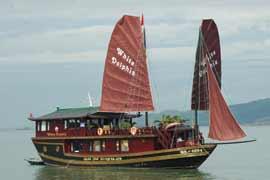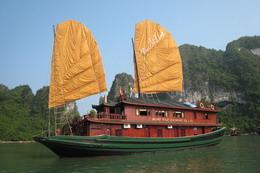Red River faces bleak future
Published: 18/03/2011 05:00
For thousands of years, poor subsistence-level communities have survived on the bounty of the Red River. In the past year or so, their way of life has changed dramatically. Hong says that for the past year, she has been using well water to irrigate her vegetable garden, due to severe pollution in the Red River. “After a few days of watering [with river water] my vegetables just wither and die, especially in the dry season,” said the farmer from Van Yen District in the northern mountainous province of Yen Bai. Hong and her neighbors say they’re in a terrible predicament. They worry that chemicals in the river may have seeped into their ground wells – which they no longer use for washing and cooking. Â “We order clean water from people living far away from the river bank,” she said. “These days, we always pull stinking black sludge out of the wells.” About 80 kilometers downstream, in the provincial capitol, many small scale vegetable farmers say they’ve abandoned the trade. Do Thi Nga has been farming in the town for nearly 50 years. This year is the first time she can recall seeing stinking black sludge. “This river pollution may have killed off my vegetables, recently,” said Nga, who lives on Thanh Nien Street in the Bo Song (River Bank) Neighborhood. In some ways, the situation is far worse for the community’s fishermen. No more fish HEAVY METALS IN Heavy metals The 1,150 kilometer Hong (Red) River begins in China’s mountainous Yunnan Province. The river stretches 556 kilometers into Vietnam, bisecting seven provinces and cities, including Hanoi, before emptying into the Gulf of Tonkin. Along with the Thai Binh River system, it has played a life sustaining role in irrigation and drainage for the region’s farmers in addition to providing an important transportation route and hydropower source. Last week, riverfront residents told Thanh Nien that low water levels and severe pollution have threatened the area’s fragile fishing and agricultural economy. Yen Bai Province’s Bo Song Neighborhood has counted on the Red River for generations. Nearly all of the residents here say their families survived on fishing. For the past year, many have taken to referring to the waterway as the “Dead” River, following a drastic decline in fish populations. Others are scrambling to find other means of support. “It used to take one hour to catch enough for a meal,” said Nguyen Van Nghi, a local fisherman. “These days, it takes a whole afternoon, just to net a snack.” To make matters worse, Nghi began pulling up noxious sludge in his nets. The ooze exuded fumes which gave him terrible headaches, he said. Another fisherman, Nguyen Van Cuong, said his family has been fishing the river ever since his grandfather moved from Hanoi to Yen Bai. Cuong recently quit the family trade and took a job transporting construction materials. “Fish and shrimp have become scarce,” he said. “Many other families have also quit fishing.” Nearby, the residents of Bao Dap Commune are also struggling with the challenges presented by the ailing river. A young fisherman named Tien said that the practice of breeding fish in floating cages had become a thriving trade before widespread pollution lead to the death of many fish. “There used to be abundant species, some of which weighed dozens of kilograms,” Tien said. “Today they only exist in the memories of old fishermen.” Less water, less silt ORGANIC SUBSTANCESÂ - Chemical oxygen demand: 1.25 times higher than the allowed level for irrigation water of 30 mg/l - Biochemical oxygen demand: 2.7 times higher than the allowed level of 15 mg/l - Total suspended solids: 20 times higher than the allowed level of 50 mg/l (Source: Lao Cai Department of Natural Resources and Environment) Thanh Nien’s request to boat up towards the Chinese border through Lao Cai Province was denied last week by provincial border guards, who cited low water levels. “The river is too shallow even for small boats [to pass],” said Colonel Luong Van Son of Lao Cai Border Guard. “You would have to wade through thick mud flats.” Hoang Thi Theo, a resident of Trinh Tuong Commune in the province’s Bat Xat District confirmed that the river has grown increasingly slight in recent years. “It looks just like a small stream,” she said. Hydrological statistics from November 2009 to April 2010 show that the river is experiencing unprecedented lows. The data also reflect record lows in three Red River tributaries: Da, Thao and Lo. The Lao Cai Department of Natural Resources and Environment said that poor rainfalls and the construction of upstream dams have seriously hurt the shrinking river. The National Hydro-Meteorological Forecasting Center recently predicted that the river’s water levels running in the Hanoi area could fall as low as 10 centimeters, during the coming dry season. The river’s low flow has alarmed a number of experts concerned with the fate of Northern Vietnam’s Red River Delta. Pham Hong Giang, Chairman of the Vietnam National Committee on Large Dams and Water Resources Development, said there has been a “notable” change in the volume and quality of water in the Red River Delta, in recent years. “Silt levels have fallen significantly and that is partly due to the upstream activities,” he said, adding that damming was certainly a contributing factor. “It was difficult to conduct inspections across the [Chinese] border; we’re only working with data on activities in Vietnam.” Dams, mines and toxic waste The Ministry of Public Security’s Environmental Police have instructed provincial authorities along the river to conduct a thorough sweep of all industrial facilities and coordinate with Chinese agencies in Yunnan Province to trace the cause of the pollution. On Tuesday (March 15), police confirmed that pollution of the river in Lao Cai Province, which borders China, had been caused by the indiscriminate dumping of untreated wastewater in both countries. Vietnamese inspectors charged that vegetable processing plants, mineral factories and riverfront hospitals in Lao Cai Town had all released toxic waste into the river. Meanwhile, many residents in Lao Cai’s Bat Xat District say that Chinese Tapioca processing facilities have seriously contributed to the problem. Mai Dinh Dinh, deputy director of the Lao Cai Department of Natural Resources and Environment, confirmed that the factories exist but declined to comment on the extent of their alleged pollution. Another official from Dinh’s office told Thanh Nien that the construction of upstream hydropower dams, some of those in China, has significantly impeded nutrient-rich silt from washing down the river. Dinh also claimed that the dams are responsible for lowering the water levels. According to the Ministry of Natural Resources and Environment, China had planned 20 hydropower plants on the upstream Red River. Eight are currently operating on the river with a peak load capacity of 1,700 megawatts. Together, the dams are capable of holding back two trillion liters of water. Nevertheless, the exact cause of the pollution and low water levels remains a subject of speculation. Nguyen Dinh Hoe of the Vietnam Association for Conservation of Nature and Environment blamed upstream mining activities for the pollution. “Recent tests have shown high concentrations of heavy metals in the river,” he said. “This level of contamination could surely result in dangerous illnesses.” Reported by Thanh Nien Staff | ||||||||||||||||
Provide by Vietnam Travel
Red River faces bleak future - Social - News | vietnam travel company
You can see more
- Belarusian Culture Days set for May 23-29 in Hanoi
- Plan for Dong Van geopark development approved
- Beginning first river bus route in Ho Chi Minh City in June
- Vietnam set to become a MICE ‘tiger’ of Southeast Asia
- Many students in Japan are in danger after snowslide
- Automated street parking piloted in Hanoi
- USAID supports Vietnam to fight wildlife smuggling
- Summer camp for overseas Vietnamese youth
enews & updates
Sign up to receive breaking news as well as receive other site updates!
- Banh Đa Cua - a traditional Hai Phong specialty
- Exploring Lai Chau cuisine
- Hanoi ranked top 3 cuisine in the world in 2023
- Beautiful resorts for a weekend escape close to Hanoi
- Travel trends in 2023
- In the spring, Moc Chau is covered in plum blossoms.
- The Most Wonderful Destinations In Sapa
- Top 3 Special festivals in Vietnam during Tet holiday - 2023
- 5 tourist hotspots expected to see a spike in visitors during Lunar New Year 2023
- How To Make Kitchen Cleaned
-
vietnam travel
http://www.vietnamtourism.org.vn " Vietnam Tourism: Vietnam Travel Guide, Culture, Travel, Entertainment, Guide, News, and...
-
Vietnam culture, culture travel
http://travel.org.vn " Vietnam culture
-
Vietnam travel, vietnam travel news, vietnam in photos
http://www.nccorp.vn " Vietnam travel, vietnam travel news, vietnam in photos
-
Vietnam tourism
http://www.vietnamtourism.org.vn " The official online information on culture, travel, entertainment, and including facts, maps,...
-
Vietnam Travel and Tourism
http://www.vietnamtourism.org.vn/ " Vietnam Travel, Entertainment, People, Agents, Company, Vietnam Tourism information.
-
Information travel online
http://www.travellive.org "Information travel online













